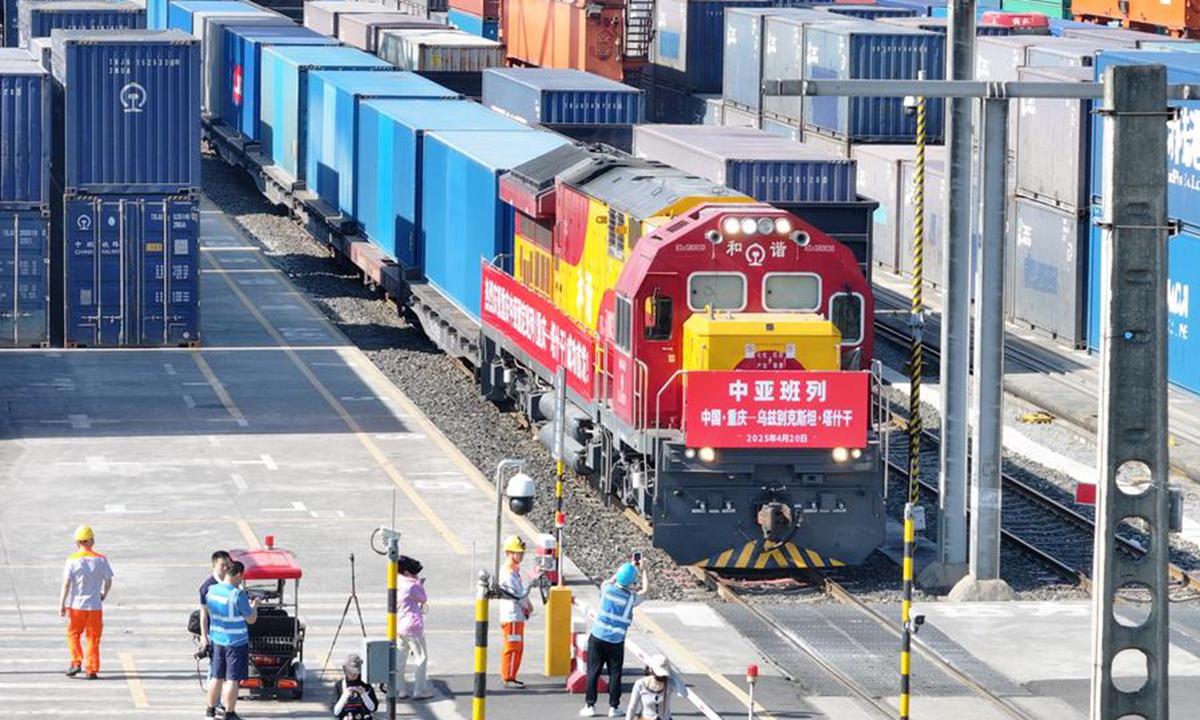
A drone photo taken on April 20, 2025 shows a China-Central Asia freight train waiting for departure at the Tuanjiecun Station in southwest China’s Chongqing. (Xinhua/Tang Yi)
Agricultural cooperation between China and five Central Asian countries – Kazakhstan, Kyrgyzstan, Tajikistan, Turkmenistan and Uzbekistan – is deepening and yielding tangible results, driving mutual growth and sustainable development, the Global Times learned from industry players and agricultural experts on Tuesday.
“China and Central Asia are deepening their agricultural ties, with cooperation spanning technology transfers, infrastructure development, and capacity building. This partnership is not only boosting local economies but also enhancing food security and sustainable development in the region,” Dai Xin, deputy director of the Agricultural Information Institute, Chinese Academy of Agricultural Sciences (CAAS), told the Global Times on Tuesday.
The remarks came as the second China-Central Asia Summit takes place in Astana, Kazakhstan, from June 16 to 18.
According to industry experts, China’s agricultural technology and expertise are playing a crucial role in uplifting Central Asia’s agricultural sector.
A modern agricultural demonstration park located in Uzbekistan showcases how agricultural cooperation between the two countries has facilitated the exchange of advanced farming technologies and the trade of agricultural produce. The CAAS and agricultural research institutions in Uzbekistan have jointly built a China-Uzbekistan experimental demonstration base and introduced Chinese cotton planting technology.
Based on this, the two sides have carried out cooperation in cotton breeding, plant protection, cultivation and other technical aspects and shared excellent germplasm resources, according to Dai.
China has been working with Central Asian countries on a range of cotton-growing projects, including technological cooperation and the expansion of cultivated areas, through multilateral cooperation platforms such as the Shanghai Cooperation Organisation and the Belt and Road Initiative (BRI), Dai said, adding that the cooperation has fully utilized local resource advantages as well as China’s technological strengths, and is highly valued by the local people and government officials.
Dai added that Central Asia’s fertile soil and abundant sunlight produce high-quality melons, grain, meat, and cotton. The two sides enjoy complementary strengths: while their agricultural resources differ, their geographic proximity facilitates close collaboration. Chinese crop varieties, technologies, machinery, and agricultural supplies are flowing outward, while products from overseas agricultural parks are entering the Chinese market, a vivid illustration of China-Central Asia agricultural cooperation.
In recent years, China has been sharing agricultural techniques and experience with numerous developing countries through platforms such as the BRI and the Forum on China-Africa Cooperation. Meanwhile, Chinese enterprises’ overseas investments in agricultural projects have enhanced local production levels and infrastructure, contributing to global food security, Dai added.
Another notable example of China’s agricultural investment is the China-Tajikistan agricultural demonstration park in Tajikistan. Since 2014, Chinese companies have been investing in the park, developing a complete cotton industry chain that includes planting, processing, spinning, weaving, dyeing, and clothing production.
Tajikistan’s natural environment, characterized by abundant sunlight and significant diurnal temperature variation, offers highly favorable conditions for cotton growth and nutrient accumulation, according to Liu Hongxia, associate research fellow of the Agricultural Information Institute of the CAAS. However, the local agricultural sector still faces challenges related to outdated technology and infrastructure.
To address these gaps, Chinese enterprises have been building a comprehensive operational system that integrates agricultural bases, industrial parks, and international trade. The Tajikistan government has also been actively supporting the growth of its agricultural park with China through incentives, including tax exemptions and guarantees for labor supply, Liu told the Global Times on Tuesday.
As Central Asian countries advance their economic and social development, their demand for digital transformation, green development, and environmental protection continues to rise. China’s industrial strengths in these fields have been widely recognized and received in the region. Future cooperation in smart agriculture, smart cities, and the energy transition is highly anticipated, Dai said, adding that through these efforts, China and Central Asian countries are strengthening their agricultural cooperation, driving sustainable development, and enhancing food security in the region.
In recent years, cooperation between China and the five Central Asian countries has deepened significantly, resulting in remarkable achievements in economic and trade exchanges and rapid growth in trade. China’s total trade with the five Central Asian countries grew by 10.4 percent year-on-year in the first five months of this year to reach 286.42 billion yuan ($39.93 billion), setting a new record compared with the corresponding periods in previous years, the Xinhua News Agency reported in June.
One of the highlights of bilateral economic and trade cooperation is the emergence of agriculture as notable growth point.
In the January-May period, China imported agricultural products worth 4.36 billion yuan from the five countries, an increase of 26.9 percent. Among these, imports of linseed from Kazakhstan soared 202.1 percent, imports of raisins from Uzbekistan grew 153.7 percent, and honey imports from Kyrgyzstan recorded a 10.9-fold increase, according to Xinhua.
This growth demonstrates the increasing importance of Central Asia as a key market for China’s agricultural trade.

